|
Royal Tragedy -
Kathmandu, Nepal (all photos are taken by myself unless otherwise noted)
It is a nation stunned and
shocked, overwhelmed with grief and sorrow. But an anger is slowly
simmering below the surface, bubbling over in some places, and ready to
explode in a revolution of the people’s frustration with the leaders
who do not lead. Nepal, cradled by the mighty Himalayas, has lost it’s
first family in an bloody massacre cloaked in very mysterious
circumstances. How to make sense of the senseless? How to explain the
inexplicable?
7:00 am, Saturday, June 2nd
All Nepal woke on Saturday morning
to find that something terrible had happened, but with no information
forthcoming, confusion reigned and rumors flew.
I had come downstairs on this
Saturday morning, ready to put in an extra day at ACP, the organization
where I was volunteering. They had decided to open to make up for the
devastating loss in productivity from the recent three-day strike. But
the entire front of the building was shuttered. I asked NawaRaj if
another strike had been called. He looked grief-stricken and stunned. As
he was mumbling no, I heard the puttering of motorbikes outside, a sure
sign that there wasn't a strike. I mentioned to NawaRaj that I was
heading to work today, even though it was a holiday. He regained his
composure and said that the office was sure to be closed. I tried to
explain that he misunderstood and that the office was open indeed. Then
he mumbled some words about the King. I immediately thought that it must
be the King's birthday or something like that, but how odd that ACP
wouldn't know that. Then it finally came out..."they are all dead,
all of them..."
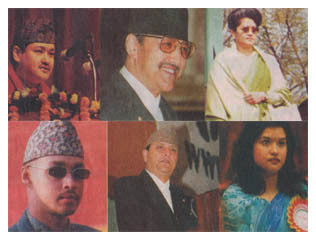
Crown Prince
Dipendra, King Birendra, Queen Aishwarya, Prince Nirajan, Prince
Gyanendra (now current King) and Princess Shruti - Kathmandu Post
With all local news and TV showing
a montage of temple pictures accompanied by mournful music, people
turned to international news agencies for any information. It wasn’t
good. The entire family of His Royal Highness King Birendra was gunned
down during a family get-together at the Royal Palace in Kathmandu. BBC
and CNN reported that nine members of the Royal Family including King
Birendra, Queen Aishwarya, their children, Prince Nirajan and Princess
Shruti, youngest brother of the King, Prince Dhirendra, two sisters of
the King, Princess Jayanti and Sharada, and both their husbands had been
massacred, allegedly by the King’s oldest son, Crown Prince Dipendra,
who lay in a coma in Chaunni Military Hospital, after turning on the gun
on himself in an apparent murder-suicide. The reason given? Over a
dispute about the Crown Prince’s choice of a wife.
I rushed to the room and turned
on the TV, but information was sketchy and sparse. To my horror, all
other stations had been blacked out. There was only CNN, BBC, StarTV
(Indian) and the state-run NepaliTV, whereas there had been a plethora
of 25 channels before. We had nothing to do but sit and anxiously wait
for any news, given in tiny bits at the top of every hour on the BBC and
CNN. After some-time, we were thrust into even more chaos when state
media also cut news channels leaving only blackness and funereal
music echoing through the building and out on the streets.
11:00 am, Saturday, June 2nd,
Durber Marg
But Nepal refused to believe. That
their King was dead and the Crown Prince responsible. Throngs of people
filled the streets of central Kathmandu looking for any answers. People
made their way to the gates of the Narayanthity Palace and the nearby
office of the Raj Parishad, (Privy Council) where they learned that an
emergency meeting had been called to name the next monarch of Nepal.
With state-run media offering no official statement, rumors were rampant
and speculation flew about the King’s second brother, Prince Gyanendra,
who was luckily or conveniently away from the Palace that night. And
people wanted answers.
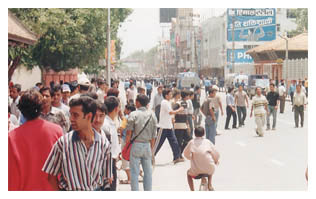
People gathering
outside the Raj Parishad on Kantipath Street
I found myself also wandering
the streets looking for answers. Durber Marg was filled with people,
some starting to chant slogans, demanding information. Police gathered
and momentum built for the inevitable confrontation. It came soon
enough, as I found myself in a human stampede of people running right
towards me. From a safe location, I watched as a row of riot police
advanced on demonstrators, lathi-charging (long wooden sticks) them. The
crowd continually surged back and forth at the onslaught of the police,
shouting pro-monarchy slogans and demanding information about their
beloved King. It was only finally dispersed with the aid of tear gas and
a long awaited announcement that came over state media stating that
there would be an official announcement at 2:00pm.
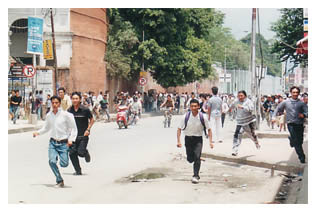
People running
from the Royal Palace intersection near Thamel after clashing with
police
2:00 pm, Saturday, June 2nd,
Office of the Raj Parishad
The announcement came over Nepal
TV and Radio Nepal. “The King and Queen and many family members had
passed away in an unanticipated event at the Royal Palace the night
before.” Crown Prince Dipendra was now named the new monarch of Nepal,
even though he lay in a coma, caused by injuries suffered in the same
unanticipated event, and in spite of the fact that he was seemingly the
gunman. No answers were given and more questions raised. Due to his
Royal Highness King Dipendra’s incapacitated state, Prince Gyanendra
was named Regent to carry out the formal responsibilities. And more
shockingly, it was further announced that the King, Queen and family
members would be cremated at Pashupati’s Aryaghat that very evening,
with the funeral procession beginning at 4:00 from the Chaunni Military
Hospital and winding through the city. As soon as the route was
announced, people began gathering to say farewell to their beloved King.
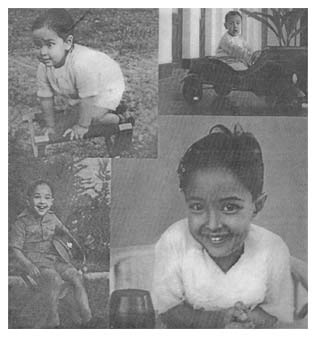
A young King
Birendra - Kantipur photo college
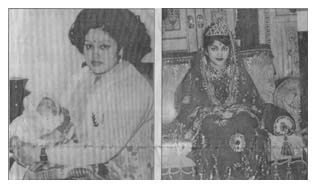
Queen Aishwarya
with the Crown Prince Dipendra and on her wedding day - Kantipur photo
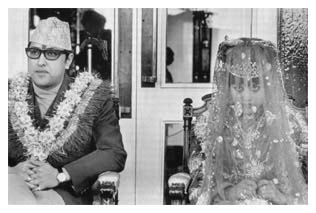
The marriage of
Birendra Bir Bikram Shah Dev and Aishwarya Rajya Laxmi Devi Shah - File
photo
They came to say goodbye to
their beloved King and Queen the royal family. They came armed with flowers
and katas (prayer scarfs) lining up shoulder to shoulder, both sides of
the entire route, and waiting sadly for the procession to arrive. My
room happened to be on the route and I sat there, alternately scanning
the TV for any sign of news, and looking out the first floor
window, waiting, waiting. At 4:00 exactly, NepalTV flickered to life and
I was greeted with the shocking image of King Birendra
4:00 Saturday, June 2nd:
Chaunni Military Hospital to Pashupatinath
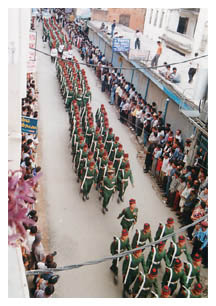 Nepal TV began televising the
state farewell at the hospital, with dignitaries and statesmen, laying
flowers atop the king, queen and their two children. Their faces were
clearly visible, their violent death etched in the twisted features of
their once regal faces. The procession began with full state and
military honors. First came the military band, followed by entire
regiments of Royal Nepal Army troops. Nepal TV began televising the
state farewell at the hospital, with dignitaries and statesmen, laying
flowers atop the king, queen and their two children. Their faces were
clearly visible, their violent death etched in the twisted features of
their once regal faces. The procession began with full state and
military honors. First came the military band, followed by entire
regiments of Royal Nepal Army troops.
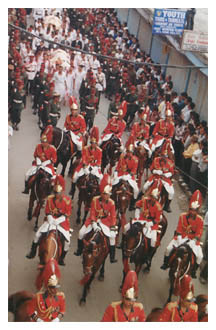
Then came the Calvary and various
other units, all wearing their full dress. Leading statesmen,
politicians and army generals followed on foot and in Mercedes vehicles.
Finally, the stark simple white dress of the Brahmin Priests could be
seen, along with their shaved, tonsured heads.
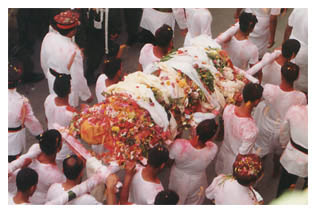
Carried on their
shoulders, in a humble bamboo cot, was the King, draped in the Nepal
flag and covered with flowers and prayer scarfs. He was wrapped in a
yellow cloth and his face was red with tika powder. The flowers rained down
from every window. People wailed in grief, tossed bouquets, and said
their final farewells, still stunned with shock at the turn of events,
at the speed of which they were occurring. People shouted, “Long live
the King” and “Our King and Our Country are dearer than our lives.”
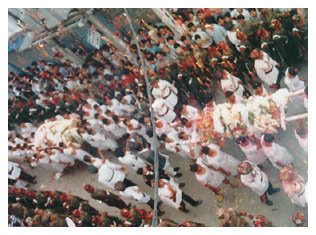
Following the King, in a regal Gold chariot carried on
the shoulder of Brahmin priests, came the Queen, reminiscent of her
wedding day, in which she was sheltered in the same carriage for her
arrival.
They were so close to me, from
my vantage point. Raised high on the priests shoulders, I found myself
face to face with death. I cried. The wailing on the street below filled
my ears. The overwhelming sadness of the moment, the stark realization
of the fragility of life, and the terrible waste of it all. I tossed my
own simple bouquet and said prayers for their departed souls as the
flowers continued to rain down around me.
Then came the Prince Nirijan,
still so handsome even in death; his youth and his potential cut short
at the age of 23. He was followed by the sweet Princess Shruti, a
favorite of the people, lover of the arts and patroness of social
welfare groups. She has left us and her two young daughter at the age of
25.
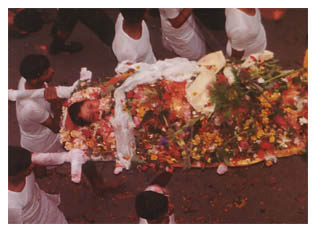
Princess
Shruti, only daughter of the King
This very public farewell was disconcerting. Death so openly on
display. Grief so overwhelming. After Princess Jayanti, passed, the
crowds surged after the procession,
intent on walking these last steps of the King, alongside him.
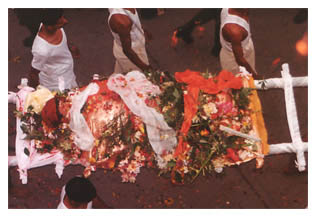
Princess
Jayanti,
second cousin to the King
Caught up in the wave of
emotion, I hurried out of my room after the procession had passed to pay
my respects to a King, who in his final years, worked tirelessly for the
upliftment of the Nepalese people. We slowly moved passed the Royal
Palace, where the procession paused for a moment in respect and then
proceeded. Slowly, the sadness turned to anger, and the rage simmering
below the surface raised its ugly head. The slogans changed from
pro-monarchy to angry recriminations. Conspiracy theories abounded and
people shouted death for the murderers. And politics made an ugly
showing, as people even denounced the already beleaguered Prime Minister
as guilty in some way of these horrific events. The streets narrowed,
and the procession was becoming dangerously crowded. Police managed to
keep control only on the front portion, while the tail of people joining
was long and very near a stampede. Fearing for my safety, I finally
turned back near the temple, sure that I would not be able to see
witness anything anyway. Once back at the hotel, I watched the sad last
rites of the Royal Family on Nepali TV.
First the King, then the Queen and
followed by Nirajan, Shruti and Jayanti. Each one was carried three
times around the flower draped wooden pyres and then laid to rest atop.
As Brahmin priests recited the holy Vedic rituals, a distant Brahmin
relative of each lit the pyre and laid fire to their mortal remains. As
the flames began to engulf the bodies, the Army gave a 56 gun salute,
statesmen stood at attention and paid their last respects, the military
band played the Nepal national anthem and an overwhelming crowd was beat
back as they surged forward. It began to drizzle, the drops falling on
Bagmati River and a commentator on TV mentioned that even the Gods were
crying. The fires leapt higher and higher and then died down to embers and
then the Royal Family was no more.
10:00 am, Sunday, June 3rd
Nepal awoke to a new reality. With
a complete lack of information, I heard the many theories. First and
foremost, the theory broadcast so prominently by the foreign media that
the now King Dipendra was responsible. As the story goes, Dipendra was
nearing his 30th birthday and still not married, quite
unprecedented and some cause for concern among Palace insiders. Dipendra
himself was taken with one young Nepali women who he met in England
while he was studying at Eton. She was also studying in England, but
came from a very wealthy family with ties to Indian government and even
some Indian blood. As family pressure was mounting to marry, he chose
this girl, but his mother objected, worried that a women was not
suitable for the future monarch of Nepal, especially given the
nationalistic sentiments of Nepalis and their underlying contempt for
any and all things Indian. On the night in question, the family was
gathering for their weekly Friday night dinner, but this one with
special overtones, to announce the engagement of Dipendra. An argument
ensued, and at one point, Dipendra, drunk and in rage left the room. He
went to his room, changed into military fatigues and returned with a
sub-machine gun and massacred his entire family. Then turned the gun on
himself. The Nepalese people, already suspicious of foreign
intervention, are angry that foreign news media jumped to conclusions
and broadcast such accusations against their Crown Prince without
confirmation or supporting information.
Matters were not helped when in
his first public proclamation, Regent Prince Gyanendra announced on
Sunday that the incident at the Palace had been a tragic accident in
which a machine gun has accidentally discharged. The Nepalese were not
so stupid as to believe that a gun could accidentally ‘target’ and
kill nine people and injure many others. In doing so, the already
unpopular Gyanendra, lost all credibility. The news media was no help
either. In following these events, I am completely baffled at the lack
of details and the superficial and univestigative manner of TV and news
media. The papers are uninformative and distinctly obtuse in reporting
anything inflammatory or anti-monarchy. In fact, the theory broadcast by
foreign news media was not even mentioned in any of the papers. Instead,
there were pages and pages of condolence messages on the “untimely
demise of the Royal Family in an unanticipated event.” I am certain
that the Nepalese people are not interested in reading a laundry list of
foreign dignitaries that sent their condolences, so much as who was
there at the palace, who was injured, where were security personnel, why
were the bodies cremated so quickly, what are the results of the
post-mortem reports…
The streets felt shell-shocked.
Similar to a strike with many offices and stores shuttered, but
different with many people venturing out to discuss and vent and share
their grief. Transportation was running, but greatly diminished. Many
didn't venture out on motorbikes or taxis in fear that violence could
break out at any time. And there was a run on newspapers. Anyone with a
paper had a huge crowd gathered around, trying to read with him. Every
newspaper vendor sat before an empty ground waiting for the next
delivery which would promptly sell out in five minutes. People were
slightly injured in various locations around Kathmandu, in a rush to get
a paper.
8:00am, Monday, June 4th
Again, Nepal awoke to a new
reality. News media announced that His Royal Highness King Dipendra had
succumbed to his injuries Sunday night. Nepal had lost another King and
the Raj Parishad was annoucing the next. Three kings in three days. It
was announced that Regent Prince Gyanendra was to be Nepal’s new
monarch. Already an unpopular figure, Gyanendra was a businessman with
suspicious ties and thought to be very corrupt. In addition,
Gyanendra’s only son Paras, was hated by the public as he was a loose
cannon; wild and uncontrollable. Already having killed three people
while driving drunk, the last straw came when he, last year, mowed down
a very popular singer in his SUV. The thought of Gyanendra as the new
King and Para being named the Crown Prince was too unbearable for many
Nepalis. Immediately after the rushed swearing-in ceremony which was
strictly controlled and secured by the army, Nepali took again to the
streets to protest the new king and to demand answers. Crowds gathered
on the major arteries of the city. And the demonstrations turned
violent. Attempting to disperse the crowds, police lathi-charged and
tear-gassed the angry mobs. The streets of the capital looked like a
battlefield with burning tires, stones, uprooted trees, and overturned
cars blocking the way. Dozens were injured when police fired bullets to
disperse crowds. And finally a curfew was announced with order to shoot
anyone who defied it.
Hearing the call for a curfew
to start shortly, I decided it was time to leave the Valley and head for
the peace and security of my family in Pokhara. Devi and I headed out
by motorbike, our only option given that many buses were not
running and those that were, were dangerously crowded. A light rain
greeted us at the start of the journey, and quickly became a downpour
through which we drove on, oblivious. We stopped in Malekhu, about two
hours outside of Kathmandu. There we rehashed all the events of the
previous days with Mama and Maiju, Devi's uncle and auntie, who owned
one of the many dhal bhattis, that line the tiny bazaar town to serve
the trucking trade. They knew even less out here. With no TV, they had
only heard what Nepali government wanted them to hear.
Amidst all this rioting and the
declaration of curfew, the state funeral of late King Dipendra was to
take place that very evening, with no one allowed to turn out to say
farewell. Despite this, thousands defied the curfew and surrounded
Chaunni Hospital to block the procession from making it’s way to
Pashupati. People demanded answers and a impartial post-mortem before
Dipendra’s mortal remains were given to flames, but they were
valiantly overcome by the army and over 500 were arrested in the course
of the protests.
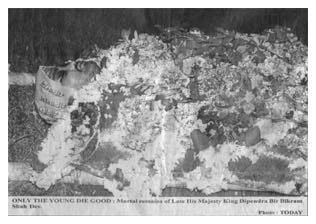
King Dipendra
laid in state. The caption reads 'Only the Young Die Good' - Space Time
Today photo
We listened to Dipendra's
procession beginning over the radio. Outside, trucks lined up and
parked, resigned to waiting in Malekhu with all entrance and exits from
the Valley sealed. Not heeding their requests to stay, we got on the
motorbike, adjusted the trash bag I was using as a jacket and we
continued on to Pokhara, trying to beat the setting sun and the
worsening conditions.
Dipendra rode to Pashupati via a
deserted Ring Road aboard the open platform of a semi-truck. That night,
he was consigned to the flames amidst full state honors, much like his
father two nights before.
We had a blowout halfway
between Dumre and Damauli. Exactly halfway. We pulled the bike over to a
nearby house and Devi asked them where the nearest place to get it
fixed. They pointed in both directions and Devi went out to the road and
waited for anyone come in either direction. The roads were deserted and
the few vehicles that did come by, ignored him in the newly tense
atmosphere of Nepal. Finally, a truck pulled over and gave him a lift
too Dumre. Meanwhile, I sat with the family of the house where the bike
was parked. We talked about the King and they were eager for any
information. Villagers came from all around to hear what I had to say.
As we sat talking, a fistfight broke out in the crowd and the nice
family ushered me into the house and closed the door to keep me safe.
Devi finally came back as night settled over Nepal. It took a half hour
to get the wheel back on the bike and the brakes and gears adjusted. It
was dark and we did it by flashlight with the help of the boys of the
house. Then we left, their address tucked in my pocket. So much for the
beating the darkness...
Tuesday, June 5th
&
Wednesday, June 6th
The government’s crude attempts
to control and suppress the truth surrounding the incident has become
clearer with each passing day. First, all TV channels were blacked out,
but after some time, CNN, BCC and some Indian News channles were allowed
back on. This was followed by cutting phone service from the capital to
the rest of the country as Kathmandu in a feeble attempt to block news
of the unrest and riots. But still, they spontaneously sprang up in all
parts of the country, and phone service was soon restored. Then, after
some Indian news media began to mention the idea of a conspiracy, these
channels were blacked out again. Then three publishers of a leading
newspaper were arrested and charged with sedition for publishing an
opinion article hinting at a conspiracy behind the murders.
Sarita came to me and showed me
an article in the Nepali paper Kantipur. She was amazed at the words in
the article written by Dr. Baburam Bhattarai, leader and mouthpiece of
the Maoists. Here he was writing what everyone was thinking. What
everyone wanted to believe. A big lie that was easier to swallow than a
small and painful truth.
With the lack of information, this
conspiracy theory was already gathering strength in the minds of
people. But it lays out a plot so deep and so machiavellian as to
shake the very foundation of Nepal. While there is no denying that the
Crown Prince was having a family disagreement about his upcoming
marriage, this was a convenient excuse to cover up something far more
sinister. A bit of background is necessary to understand the current
situation. Prior to 1990, Nepal was an absolute monarchy cloaked in a
partyless ‘pancyhat’ system of governance, rife with corruption, and
ruled absolutely by the King himself. But the frustrations and
aspirations of the people led to the popular 1990 Jana Andolan
democratic uprising, in which King Birendra bowed to the people’s
wishes and established a multi-party parliamentary system and
constitutional monarchy, where he was reduced to a ceremonial
figurehead. Today, King Birendra is loved and remembered so fondly be
the Nepalese people for what is considered his commitment to the wishes
of the people. After 1990, even as the many political parties of Nepal
seemed to make a mockery of democracy by institutionalizing corruption,
King Birendra seemed to be the only true person committed to the
constitution and to govern wisely and for the betterment of the people,
even within his limited capacity. It is within this framework that the
events should be viewed.
The King’s brother
Gyanendra,
was widely known for his anti-democratic beliefs and his desire to
return to an absolute monarchy. Recently, the army chiefs had caused
some alarm with some statements that seemed to indicate that the army
was controlled by the King and not by the elected government, and the
dispute had not been resolved. All parties of the government have
recently been rocked by corruption scandal, and the main opposition
party, the Communists had disrupted the last session of parliament to
demand the resignation of the Prime Minister. With the government in
disarray, democracy is at it’s most vulnerable. Many believe Gyanendra
to have orchestrated the turn of events to grab power for himself and
with the backing of the army, to throw out democracy and return to an
autocratic rule. There certainly seems to be many factors supporting
this. First, for Gyanendra to ascend the throne of Nepal, King Birendra,
Crown Prince Dipendra and Prince Nirajan would all have to die before
the line of succession would turn to him. Second, all of Gyanendra’s
family was present, except for Gyanendra himself, at the Palace that
evening, and none were killed. As if to squash such rumors, palce
officials have reported that they sustained non-serious injuries and are
recovering nicely, even though no photos or other information has been
supplied. The British Ambassador to Nepal’s residence is next to the
Royal Palace, and on the night in question, he reported hearing over
forty minutes of sporadic gunfire from the Palace. He reported this to
officials and news media and was dismissed, however, it was later
reported in the London Times. An unconfirmed report has that two army
vehicles were seen leaving the Palace and heading for Gorkha, where the
army is deployed to fight the Maoist insurgency. The theory being that
numerous army people were killed that night and their bodies are being
taken to an area of fighting only to say later that they were killed in
duty, fighting the Maoists. Everyone killed that night was cremated
within a day of their death, and no reports of the post-mortems have
released. That everyone injured and killed in the incident were taken to
a military hospital even though there are better-equipped and advanced
hospitals in Kathmandu, let alone internationally. That everyone
gathered that evening was to celebrate the engagement of Dipendra and
his own uncle was conveniently away. Another unconfirmed report that
Dipendra died of injuries sustained from a bullet wound to the back. And
finally, the complete lack of information on the whereabouts of Paras,
who is widely believed to have had carreid out the actual murders.
People again took to the
streets. I escaped Kathmandu for the relative calm of Pokhara, and to
share in the sorrow of my Nepalese family. But even Pokhara was not
immune. As all the stores and shops were closed due to state mourning
for eight days, Devi and I went to Lakeside to find an open cyber café.
There, we ran into our friend Narayan who was demonstrating with a large
crowd. They were standing outside the Royal Retreat in Lakeside, yelling
Paras Chor (loosely translated as Paras Thief but a very slang term with
very ugly overtones) They believed that Paras was in town and hiding out
inside the building. I left to do my business and then went to visit a
friend in nearby Damside. Tika and Shova have a small six-month-old baby
girl and as I approached their building, I heard the most pained
wailing. Rastra Chowk, the intersection near their building had just
been the scene of a clash between the demonstrators on the move and
police. Tear gas was fired to disperse the crowd and it seeped into all
the nearby buildings. Poor Sanu had it in her eyes and she could do
nothing but cry and cry. Tika was still fanning the air as we sat and
talked. As the demonstrations spread across Pokhara, Devi decided we
should return home.
As we passed Mahendra Pol,
the main shopping bazaar, I saw tires burning, and rocks littering the
streets. As people ran by, we heard from the crowd that they moving
against the Army Barracks just east of the bazaar. Seems they were now
convinced that Paras was holed up in there after an army vehicle was
seen leaving the Royal Retreat for the Barracks. Then I felt the sting
of tear gas in my eyes and nose. Like pepper but a hundred times worse.
I shut my eyes and clamped my fingers on my nose, but the gas just
burned my throat. Mahendra Pol looked like a war zone. Police in riot gear
advancing on stone throwing youth. We raced for home and there, aama
made us eat onions to take away the burn.
Incidents were reported in all
major towns of Nepal. Matters have died down, but the feelings of
frustration linger on. A semblance of normalcy is slowly returning, but
things will never be the same. As Nepal suffers setback after setback in
its struggle to develop, I am a witness to the strength and tenacity of
a people that persevere despite all odds. In perhaps one bittersweet
show of unity, almost all men in Nepal have shaved their heads in
mourning, a sign of grief and respect for the dead usually reserved for
when one’s own parents have died. In this way, all Nepalis have been
orphaned. In a country where there are over two hundred ethnic groups,
over sixty languages, large refugee populations from Tibet and Bhutan, a
raging insurgency, a corrupt government prone to divisiveness and an
insidious caste system that serves only to create social division, the
King was perhaps the last unifying factor to bring people together.
Whether this tragedy serves to unify the people for the difficult road
ahead or bring Nepal to the brink of the abyss, no one knows. I hope it
will not be shown in the future to have been the last straw.
return to Current Issues in
Nepal
|
